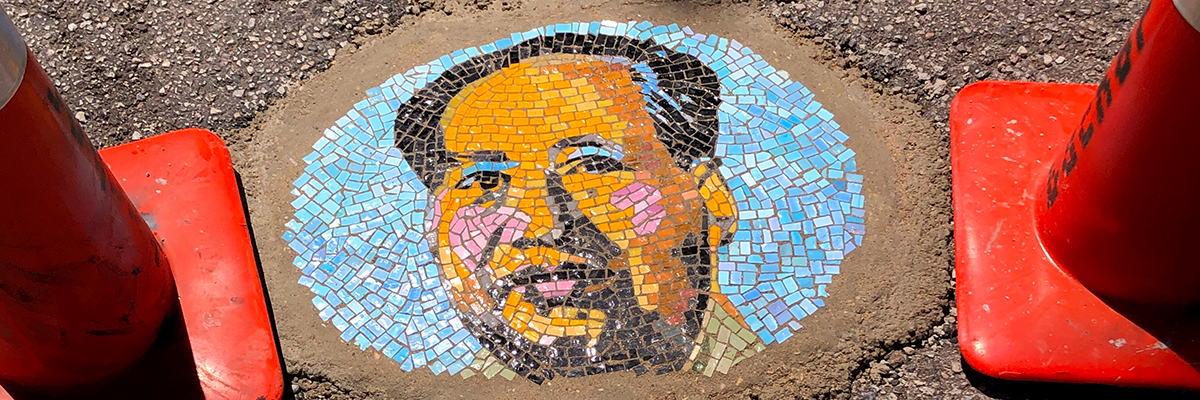Jim Bachor puts his mosaics in potholes. It is unusual for sure. Even absurd.
When it comes to the topic of ephemeral art, absurdity is part of the street art game.
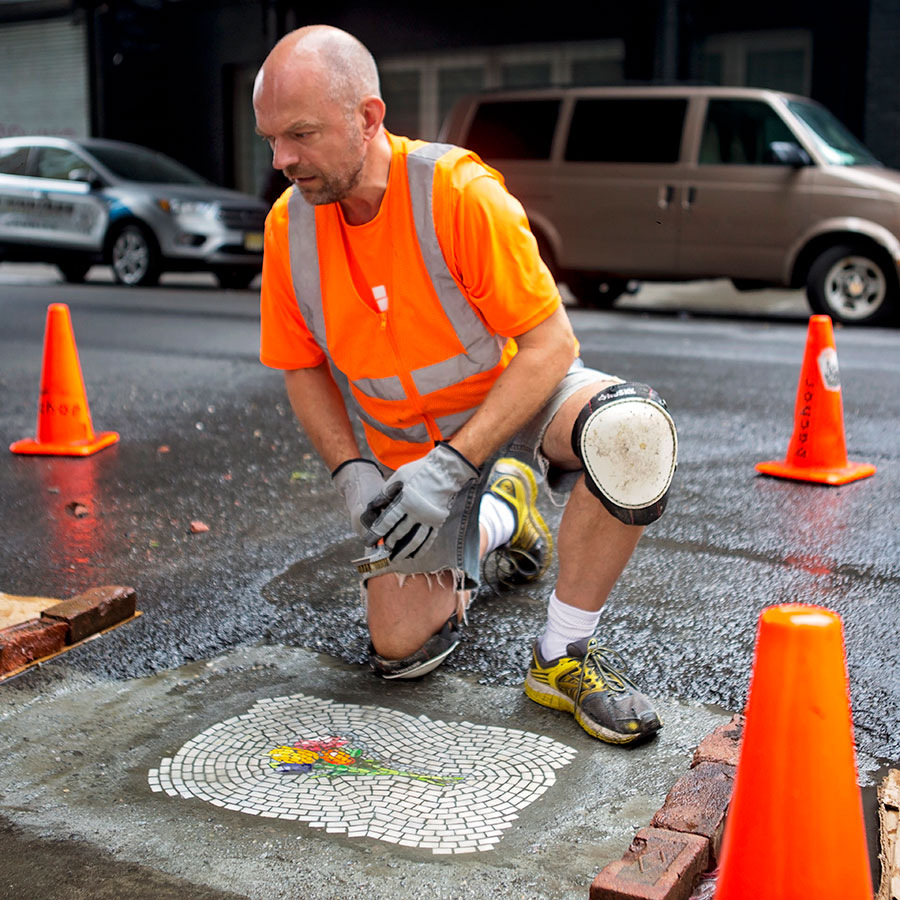
“This work is my mark,” says Chicago street artist Jim Bachor, and he points to the ancient practice of making mosaics as his inspiration. The artist began his project of laying tiles in the street as a way to advertise his fine art website online but found the practice to be addictive. These days he doesn’t just create random images of a bag of chips or a bouquet, he’s tiling details of masterworks from the Art Institute of Chicago’s permanent collection.
He says he has developed a process of working in the broad daylight that makes him nearly invisible in a busy city and uses precautions not to get hit by cars because, “with two 16-year-old boys at home, I purposely avoid situations where the risk isn’t worth it.”
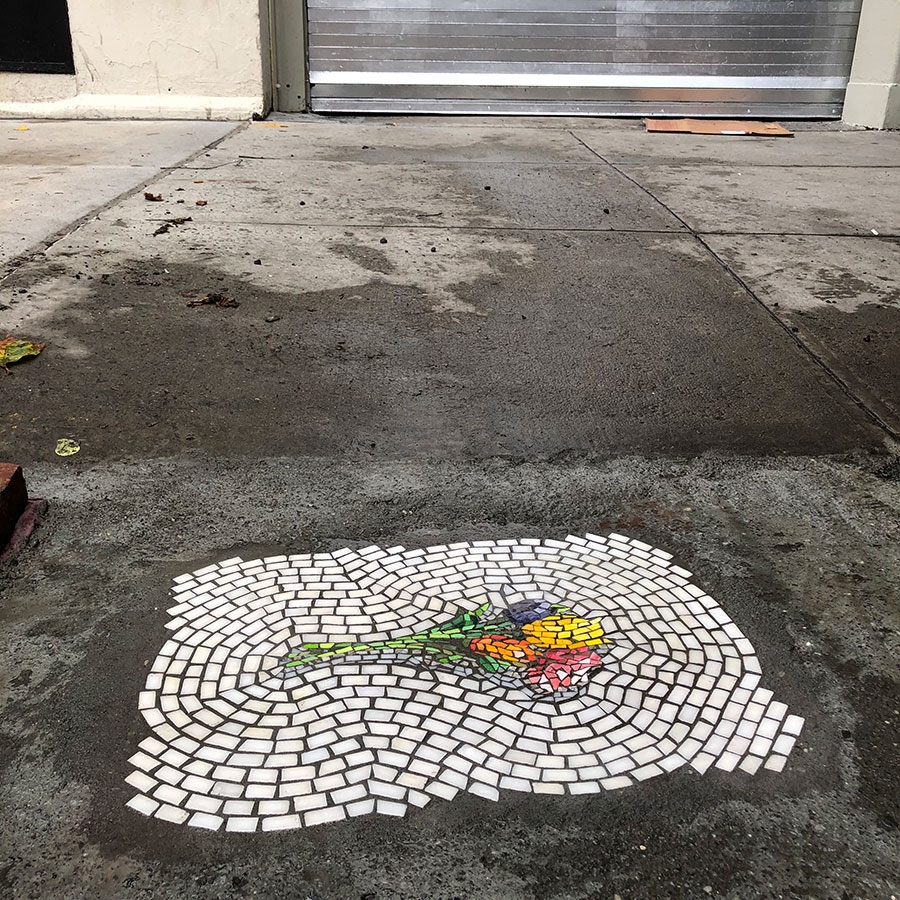
BSA talked with Bachor about his practice on the street, and how to have a sense of humor about it all.
BSA: Pedestrians, cyclists, and motorists all despise potholes; you on the other hand are attracted to them like urban pigeons are attracted to sidewalk pizza. The Biden administration just signed a milestone infrastructure bill…are you concerned you’ll run out of potholes?
JB: I am not. I think potholes are an unsolvable problem. Unless cities decide to pull up all their asphalt streets and replace them with expensive concrete ones the problem won’t go away. I sympathize with city governments; unless how streets are fabricated changes, it’ll remain an unsolvable problem. Plus fixing streets keeps people employed.
BSA: Have you ever traveled in time and found yourself thriving during the Byzantine Empire? The work of the mosaic artists from the 15th century is still assiduously studied today. Your work is far more ephemerous. Do you wish your potholes creations were preserved for future generations? Are you always cognizant of the fact that most likely your work will be destroyed?
JB: I have traveled back in time but much earlier, more like the height of the Roman Empire, maybe around the 1st century AD. While it would be great for my pothole art to last for generations, this itch is scratched with the majority of my other work which isn’t pothole art. My fine art pieces have the chance of lasting a very long time – all while still looking the same as when they were first created. I purposely keep most of my pothole art relatively simple to fabricate. I can’t sell the original artwork stuck in the ground, only limited edition prints of it.
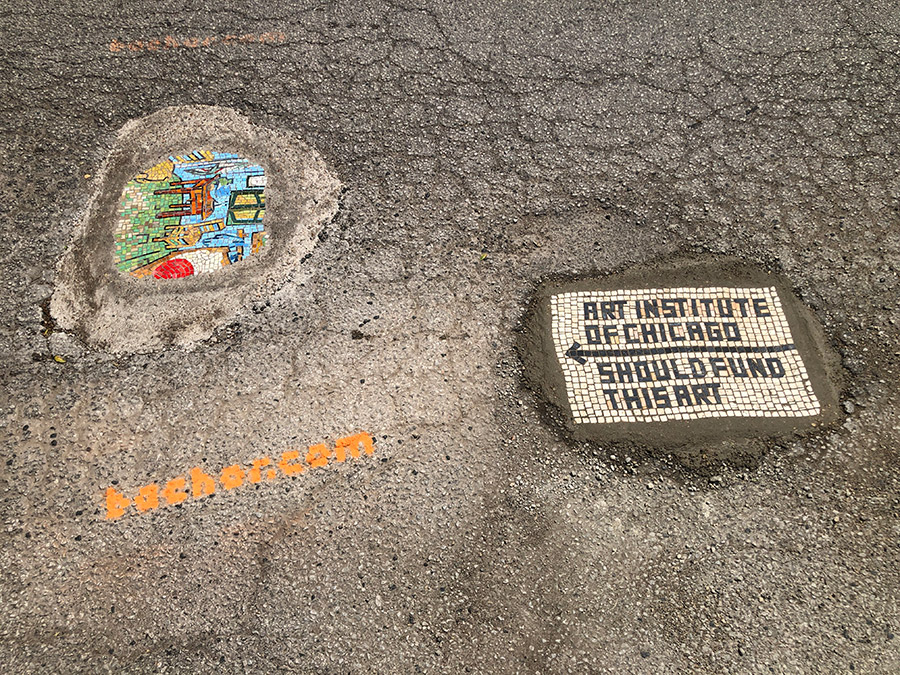
BSA: Is it your intention to send messages to people with your art on the streets or are you looking to amuse them, make them smile, and inspire them?
JB: It’s really kind of to poke fun at ourselves and the times we live in. Juxtaposing potholes (which everybody hates) with unexpected subject matter that everyone loves (like junk food or flowers). Kinda like an Easter egg hunt. Unexpected grins. Someone once said that unexpectedly running across a piece of pothole art is like seeing Jesus’s face in a tortilla. Sounds about right.
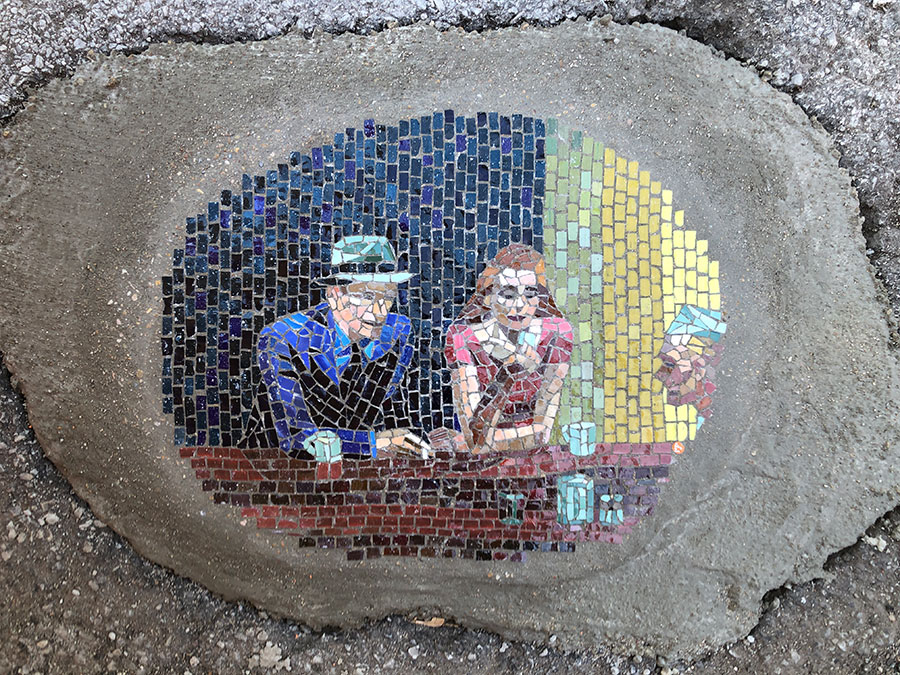
BSA: The Greeks used mosaics to build roads; while they were at it, they figured, well let’s make patterns with the little pebbles we are using…you are filling potholes with mosaics on the streets also with patterns and images…do you find the similarity amusing?
JB: I’m not so sure about the premise of this question! Greeks did some of the earliest mosaics in pebbles but I never heard of them using them in the construction of roads. I’d need to see proof of this!
BSA: Are you aiming to simply repair roads with art while you are at it, or are you using the potholes as canvas, sort of site-specific installations and road reparation is the farthest thing in your mind?
JB: It’s truthfully a case of “potholes as a canvas.” The initial idea for the campaign was to hopefully draw attention to the artwork on my website (bachor.com). The repair wasn’t part of my thought process. Trying to draw attention to the pothole problem wasn’t part of my thought process. Pothole art is kinda like an open-air gallery that’s open 24 hours a day to anyone interested.
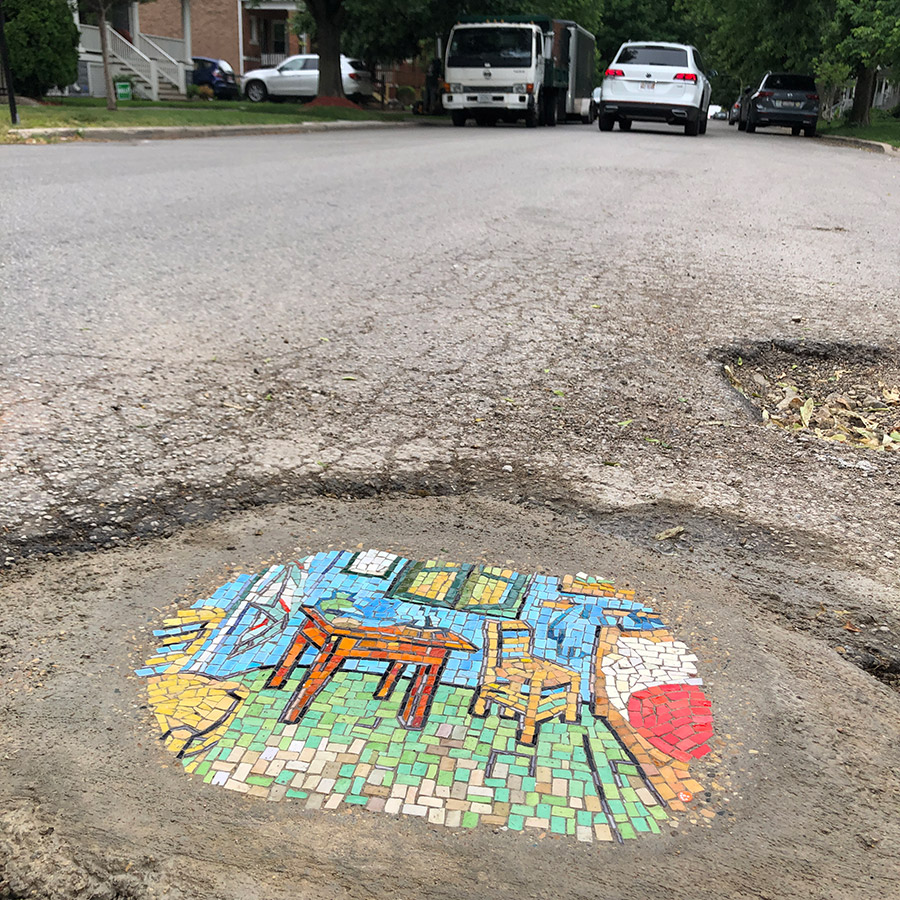
BSA: Have you ever gotten cease-and-desist letters from the municipalities to prevent you from creating art in their potholes? Do the authorities consider you a vandal?
JB: Never. I’ve never had direct contact with anyone in any city government. I’ve never heard anything directly from authorities about what they’ve thought about my work. However, once the New York City Department of Transportation learned of a campaign I did there (“Vermin of New York”) back in 2018 through a New York Post reporter – they pulled up all of my installs within a week! It’s the only time anything like this has ever happened.
BSA: Sometimes, you take inspiration from existing artworks to create your own works. Do you prefer pop and contemporary art, or do you feel equally comfortable with classic pieces of art when designing your mosaics to install on the streets?
JB: With the exception of my recent “Master Pieces” – which featured details of masterworks from the Art Institute of Chicago’s permanent collection – I really don’t look for inspiration from other people’s work. Although I know I’m inspired by what I’ve been exposed to in life I don’t go out of my way to look for inspiration. I think about ideas that are funny or interesting and just go from there. There’s certainly a nod to modern consumerism in some of my work that you can trace back to my years in the ad biz.
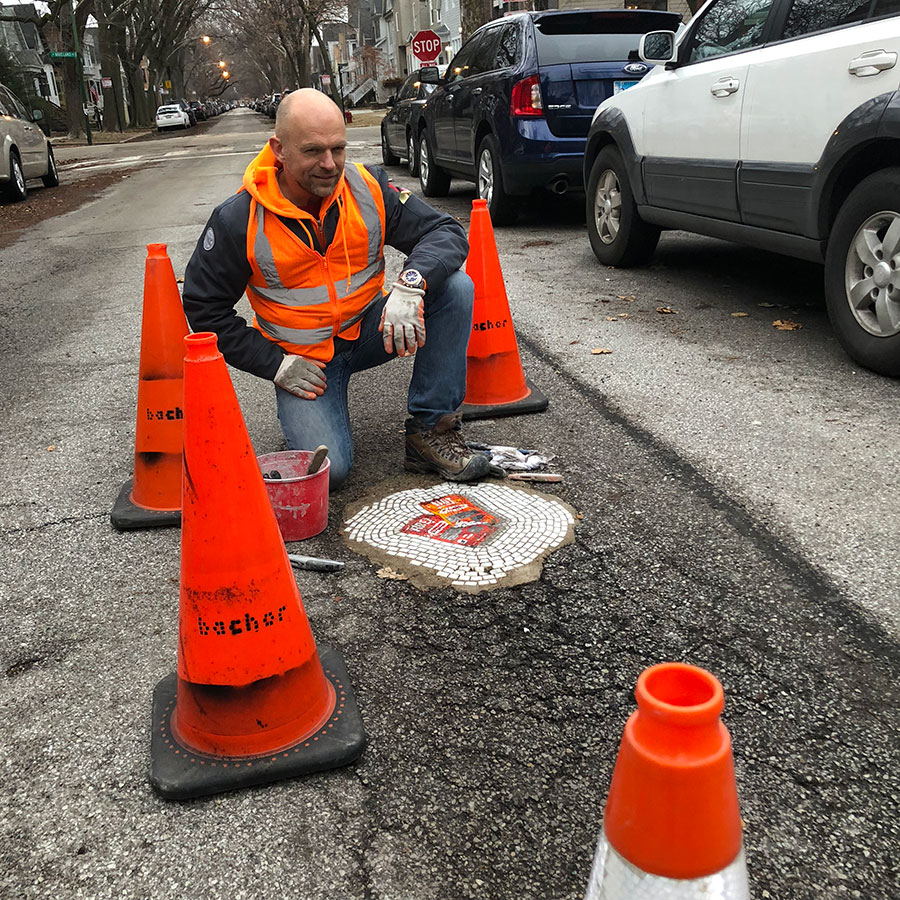
BSA: We find a sense of humor in some of your mosaics. Do you find yourself thinking that you are creating mischief on the streets with your art? Is that your intention? To be mischievous?
JB: Yes! I love the absurdity of it all. Who would spend all this time making a mosaic of a bag of Cheetos and then installing it in the street? Ridiculous. Fun. Unexpected. I like the idea of someone walking down the sidewalk and catching a glimpse of something in the street that shouldn’t be there. And it gets more interesting from there… Who doesn’t like an unexpected surprise?
BSA: When you make a mosaic on the streets in a pothole you leave it there. Can’t sell it. How do you finance your work? The cost of your materials?
JB: Yep. Each install runs about $100 in materials to produce. In the case of this year’s “Master Pieces” series, it was much more as they were fabricated entirely in expensive Italian glass. They are mostly self-financed. In the past, I’ve done Kickstarter campaigns to help pay for them. These days sales of limited edition prints of the pothole art installations help recoup costs and hopefully turn a profit.
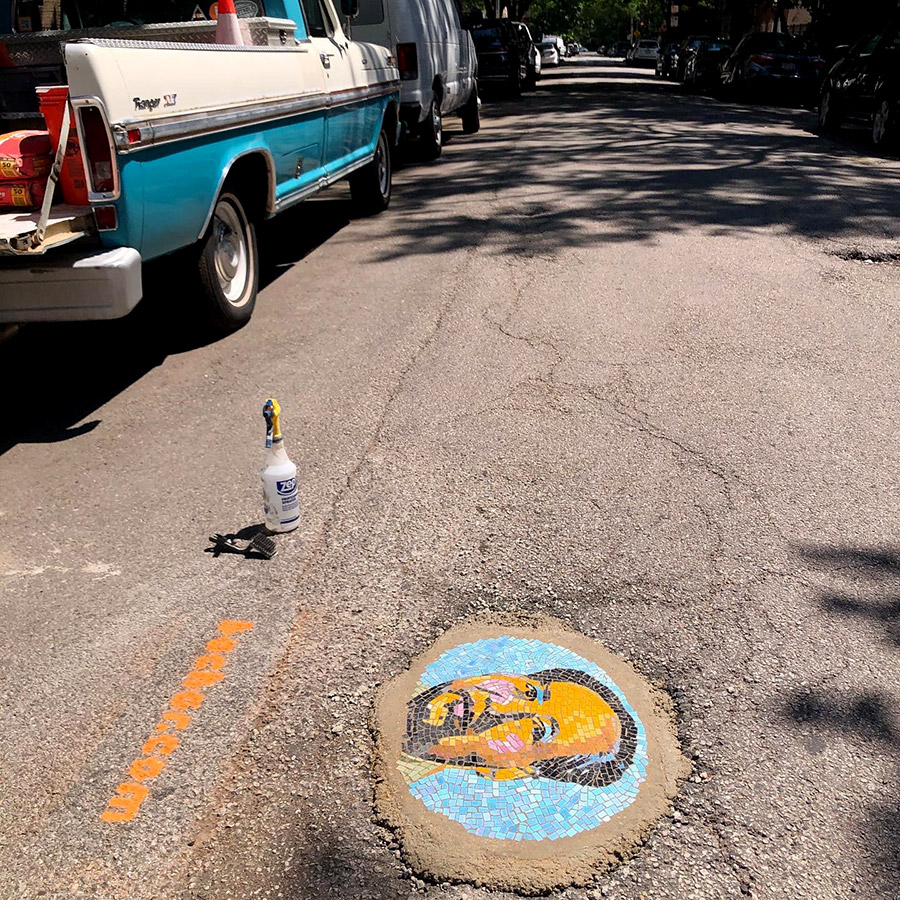
BSA: We assume that your work is always illegal (if you were to wait for permits nothing would ever get done, correct?). Do you work under the cover of the night using a helmet light? When you work during the day without a permit, do you feel in danger from speeding cars, bicycles, skaters, and crazy drivers?
JB: If I had originally asked for permission from the city to do this we wouldn’t be having this conversation. The campaign would have never happened. I still don’t know if it’s illegal or not! My guess is if it were illegal I’d know about it by now. I started out doing installs at night to be covert about it. But it just looked more suspicious not less. I settled on mid-morning or mid-afternoon to avoid rush hours. People have their own lives to lead and if you look like you should be there no one notices or cares. Yes, there is an element of danger, but I try to be careful as this would be a really stupid way to die. Especially with two 16-year-old boys at home. I purposely avoid situations where the risk isn’t worth it.
BSA: People who live in a large, congested metropolis like NYC often find themselves coming out of the subway tunnels feeling a bit disoriented and not knowing North from South, therefore walking a long block before realizing that they are headed in the wrong direction. Can you think of a practical way of helping these poor, helpless souls find their way with your installations?

JB: I have thought about this as I’ve experienced being disoriented as you say. Why not simply install a giant N in the ground with an arrow pointing north? It would go a long way to quickly getting people where they want to go.
BSA: The end of winter is pothole heaven. Do you find yourself feeling restless come April?
JB: Like a squirrel that is hoarding nuts, I try and build up a supply of pothole art pieces over the winter. Once it (hopefully) warms up in April, I can hit the ground running.

Other Articles You May Like from BSA:
Welcome to BSA Images of the Week. Happy Easter! Sameach Pesach! Ramadan Mubarak! It's a rare year when all three of these holidays are happening at the same time. It's a religious trifecta th...
Shopping at an art fair this week? Why not buy something that directly benefits the culture that street art and graffiti came from? In Mongolia. Martha Cooper in collaboration with Learn &...
Barcelona Street Art may have been booted from many streets a few years ago during a period of commercial fueled gentrification but that organic scene sparked a generation of talents who continue to t...
The influence of Street Art and graffiti continues to disperse through cities, towns and the countryside of many regions in the form of mural festivals. The village of Penelles in Catalonia asks resid...
Over the holidays we made a quick stop in West Palm Beach, Florida to take a look at the murals from the CANVAS program, adjacent to the neighborhood of the Trump resort where he spent New Year's ...
 BROOKLYN STREET ART LOVES YOU MORE EVERY DAY
BROOKLYN STREET ART LOVES YOU MORE EVERY DAY